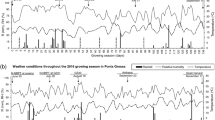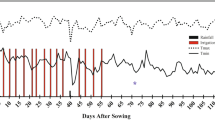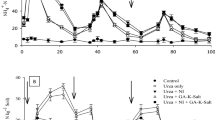Abstract
This research was developed to investigate the use of Azospirillum brasilense to enhance N use in wheat cropping systems and to assess the potential interactions between inoculation and urease inhibitor N-(n-butyl)thiophosphoric triamide (NBPT). The study was set up under a no-till system in a Rhodic Hapludox. The experimental design was a randomized completely block design with four replicates arranged in a two N source (urea with and without NBPT) × five N rate applied as side dress (0–200 kg ha−1) × two inoculation (with and without A. brasilense) factorial scheme. Inoculation with A. brasilense in combination with application of 100 and 150 kg N ha−1 was found to increase grain yield by 19.6 and 18.8%, respectively. Inoculation also increased biomass N uptake by 66.9% when N was omitted. Inoculation and NBPT application were found to increase NUE by 23.7% compared to inoculation in combination with conventional urea and by 140% compared to NBPT without inoculation. In addition, inoculation increased plant height and NUE by 13.2 and 49%, respectively, compared with non-inoculated plots. Conventional urea and urea with NBPT had a similar effect on nutrient concentration, N uptake, leaf chlorophyll index, biomass weight and wheat grain yield. This study showed positive improvements in wheat production parameters as a result of inoculation, but the potential benefits of NBPT use were less evident. Further research should be conducted under growing conditions that provide increased N volatilization to better study the potential of NBPT application.

Similar content being viewed by others
References
Abalos D, Jeffery S, Sanz-Cobena A, Guardia G, Vallejo A (2014) Meta-analysis of the effect of urease and nitrification inhibitors on crop productivity and nitrogen use efficiency. Agric Ecosyst Environ 189:136–144
Alfaro M, Salazar F, Hube S, Ramírez L, Mora MS (2018) Ammonia and nitrous oxide emissions as affected by nitrification and urease inhibitors. J Soil Sci Plant Nutr 18:479–486
Alves CJ, Arf O, Ramos AF, Galindo FS, Nogueira LM, Rodrigues RAF (2017) Irrigated wheat subjected to inoculation with Azospirillum brasilense and nitrogen doses as top-dressing. R Bras Eng Agr Amb 21:537–542
Arif MS, Shahzad SM, Riaz M, Yasmeen T, Shahzad T, Akhtar MJ, Bragazza L, Buttler A (2017) Nitrogen-enriched compost application combined with plant growth-promoting rhizobacteria (PGPR) improves seed quality and nutrient use efficiency of sunflower. J Plant Nutr Soil Sci 180:464–473
Artola E, Cruchaga S, Ariz I, Moran JF, Garnica M, Houdusse F, Mina JMG, Irigoyen I, Las B, Aparicio-Tejo PM (2011) Effect of N-(n-butyl) thiophosphoric triamide on urea metabolism and the assimilation of ammonium by Triticum aestivum L. Plant Growth Regul 63:73–79
Bramble DSE, Gouveia GA, Ramnarine R (2019) Organic residues and ammonium effects on CO2 emissions and soil quality indicators in limed acid tropical soils. Soil Syst 3:16
Breda FAF, da Silva TFR, dos Santos SG, Alves GC, Reis VM (2019) Modulation of nitrogen metabolism of maize plants inoculated with Azospirillum brasilense and Herbaspirillum seropedicae. Arch Microbiol 201:547–558
Cantarella H, Raij B van, Camargo CEO (1997) Cereals. In: Raij B van, Cantarella H, Quaggio JA, Furlani AMC. Liming and fertilization recommendations for the State of São Paulo. (In Portuguese.) Campinas: Instituto Agronômico de Campinas; 285p. (Boletim técnico, 100)
Cantarella H, Otto R, Soares JR, Silva AGB (2018) Agronomic efficiency of NBPT as a urease inhibitor: a review. J Adv Res 13:19–27
Cardillo BES, Oliveira DP, Soares BL, Martins FAD, Rufini M, Silva JS, Ferreira Neto GG, de Andrade MJB, Moreira FMDS (2019) Nodulation and yields of common bean are not affected either by fungicides or by the method of inoculation. Agron J 111:694–701
Cassán F, Diaz-Zorita M (2016) Azospirillum sp. in current agriculture: from the laboratory to the field. Soil Biol Biochem 103:117–130
Companhia Nacional de Abastecimento (CONAB) (2019) Grains report—November 2019. Brasília: CONAB (in Portuguese). https://www.conab.gov.br/info-agro/safras
Cormier F, Foulkes J, Hirel B, Gouache D, Moenne-Loccoz Y, Le Gouis J (2016) Breeding for increased nitrogen-use efficiency: a review for wheat (T. aestivum L.). Plant Breed 135:255–278
Cruchaga S, Lasa B, Jauregui I, Gonzáles-Murua C, Aparicio-Tejo PM, Ariz I (2013) Inhibition of endogenous urease activity by NBPT application reveals differential N metabolism responses to ammonium or nitrate nutrition in pea plants: a physiological study. Plant Soil 373:813–827
de Bashan LE, Hernandez JP, Bashan Y (2012) The potential contribution of plant growth-promoting bacteria to reduce environmental degradation—a comprehensive evaluation. Appl Soil Ecol 61:171–189
Dobbelaere S, Croonenborghs A, Thys A, Ptacek D, Vanderleyden J, Dutto P, Labandera-Gonzalez C, Caballero-Mellado J, Aguirre JF, Kapulnik Y, Brener S, Burdman S, Kadouri D, Sarig S, Okon Y (2001) Response of agronomically important crops to inoculation with Azospirillum. Aust J Plant Physiol 28:871–879
Dougherty WJ, Collins D, Van Zwieten L, Rowlings DW (2016) Nitrification (DMPP) and urease (NBPT) inhibitors had no effect on pasture yield, nitrous oxide emissions, or nitrate leaching under irrigation in a hot-dry climate. Soil Res 54:675–683
Dutta B, Congreves KA, Smith WN, Grant BB, Rochette P, Chantigny MH, Desjardins RL (2016) Improving DNDC model to estimate ammonia loss from urea fertilizer application in temperate agroecosystems. Nutr Cycl Agroecosyst 106:275–292
Embrapa (2017) Manual of soil analysis methods (in Portuguese). Centro Nacional de Pesquisa de Solos, Rio de Janeiro, p 575
Engel RE, Williams E, Wallander R, Hilmer J (2013) Apparent persistence of N-(nbutyl) thiophosphoric triamide is greater in alkaline soils. Soil Sci Soc Am J 77:1424–1429
Engel RE, Towey BD, Gravens E (2015) Degradation of the urease inhibitor NBPT as affected by soil pH. Soil Sci Soc Am J 79:1674–1683
Falker Automação Agrícola (2008) Manual of electronic chlorophyll meter (ClorofiLOG/CFL 1030) (In Portuguese). Falker Automação Agrícola, Porto Alegre
Fang Y, Du Y, Wang J, Wu A, Qiao S, Xu B, Zhang S, Siddique KH, Chen Y (2017) Moderate drought stress affected root growth and grain yield in old, modern and newly released cultivars of winter wheat. Front Plant Sci. https://doi.org/10.3389/fpls.2017.00672
FAO United Nations Food and Agricultural Organization (2017) Wheat yields global by country. Disponible in: http://www.fao.org/faostat/en/#data
Farooq S, Hussain M, Jabran K, Hassan W, Rizwan MS, Yasir TA (2017) Osmopriming with CaCl2 improves wheat (Triticum aestivum L.) production under water-limited environments. Environ Sci Poll Res 24:13638–13649
Fillery IRP, Khimashia N (2016) Procedure to estimate ammonia loss after N fertiliser application to moist soil. Soil Res 54:1–10
Fukami J, Nogueira MA, Araujo RS, Hungria M (2016) Accessing inoculation methods of maize and wheat with Azospirillum brasilense. AMB Express 6:3–16
Fukami J, Ollero FJ, Megías M, Hungria M (2017) Phytohormones and induction of plant-stress tolerance and defense genes by seed and foliar inoculation with Azospirillum brasilense cells and metabolites promote maize growth. AMB Express 7:153–163
Fukami J, Abrantes JLF, del Cerro P, Nogueira MA, Ollero FJ, Megías M, Hungria M (2018a) Revealing different strategies of quorum sensing in Azospirillum brasilense strains Ab-V5 and Ab-V6. Arch Microbiol 200:47–56
Fukami J, Cerezini P, Hungria M (2018b) Azospirillum: benefits that go far beyond biological nitrogen fixation. AMB Express 8:73
Fukami J, De La Osa C, Ollero FJ, Megías M, Hungria M (2018c) Coinoculation of maize with Azospirillum brasilense and Rhizobium tropici as a strategy to mitigate salinity stress. Funct Plant Biol 45:328–339
Galindo FS, Ludkiewicz MGZ, Bellote JLM, Santini JMK, Alves CJ, Teixeira Filho MCM (2015a) Effect of leaf application times of Azospirillum brasilense in the nutrients levels of wheat irrigated (In Portuguese, with English abstract.). Tecnol Ci Agropec 9:37–42
Galindo FS, Ludkiewicz MGZ, Bellote JLM, Santini JMK, Teixeira Filho MCM, Buzetti S (2015b) Leaf application times of Azospirillum brasilense in yield of wheat irrigated (In Portuguese, with English abstract.). Tecnol Ci Agropec 9:43–48
Galindo FS, Teixeira Filho MCM, Buzetti S, Santini JMK, Alves CJ, Nogueira LM, Ludkiewicz MGZ, Andreotti M, Bellotte JLM (2016) Corn yield and foliar diagnosis affected by nitrogen fertilization and inoculation with Azospirillum brasilense. R Bras Ci Solo 40:e015036
Galindo FS, Teixeira Filho MCM, Buzetti S, Santini JMK, Alves CJ, Ludkiewicz MGZ (2017a) Wheat yield in the Cerrado as affected by nitrogen fertilization and inoculation with Azospirillum brasilense. Pesq Agropec Bras 52:794–805
Galindo FS, Teixeira Filho MCM, Buzetti S, Santini JMK, Bellotte JLM, Ludkiewicz MGZ, Andreotti M, Silva VM, Garcia CMP (2017b) Chemical soil attributes after wheat cropping under nitrogen fertilization and inoculation with Azospirillum brasilense. Semina: Ci Agrár 38:659–669
Galindo FS, Teixeira Filho MCM, Tarsitano MAA, Buzetti S, Santini JMK, Ludkiewicz MGZ, Alves CJ, Arf O (2017c) Economic analysis of corn inoculated with Azospirillum brasilense associated with nitrogen sources and doses. Semina: Ci Agrár 38:1749–1764
Galindo FS, Teixeira Filho MCM, Tarsitano MAA, Buzetti S, Santini JMK, Ludkiewicz MGZ, Alves CJ (2018) Technical and economic feasibility of irrigated wheat as a function of nitrogen doses, sources, and inoculation with Azospirillum brasilense. Semina: Ci Agrár 39:51–66
Galindo FS, Teixeira Filho MCM, Buzetti S, Pagliari PH, Santini JMK, Alves CJ, Megda MM, Nogueira TAR, Andreotti M, Arf O (2019) Maize yield response to nitrogen rates and sources associated with Azospirillum brasilense. Agron J 111:1985–1997
Gomes YCB, Dalchiavon FC, Valadão FCA (2017) Joint use of fungicides, insecticides and inoculants in the treatment of soybean seeds. R Ceres 64:258–265
Hungria M, Campo RJ, Souza SEM, Pedrosa FO (2010) Inoculation with selected strains of Azospirillum brasilense and A. lipoferum improves yields of maize and wheat in Brazil. Plant Soil 331:413–425
Hungria M, Ribeiro RA, Nogueira MA (2018) Draft genome sequences of Azospirillum brasilense strains Ab-V5 and Ab-V6, commercially used in inoculants for grasses and legumes in Brazil. Genome Announc 6:e00393–18
Kaushal M, Wani SP (2016) Plant-growth-promoting rhizobacteria: drought stress alleviators to ameliorate crop production in drylands. Ann Microbiol 66:35–42
Ladha JK, Tirol-Padre A, Reddy CK, Cassman KG, Verma S, Powlson DS, Van Kessel C, Richter DB, Chakraborty D, Pathak H (2016) Global nitrogen budgets in cereals: a 50-year assessment for maize, rice, and wheat production systems. Sci Rep 6:19355
Linquist BA, Liu L, van Kessel C, van Groenigen KJ (2013) Enhanced efficiency nitrogen fertilizers for rice systems: meta-analysis of yield and nitrogen uptake. Field Crops Res 154:246–254
Ludwig RL, Martin TN, Stecca JDL, Cunha VS, Nunes UR, Grando LFT (2018) Action specificity of chemical treatment and inoculation with Azospirillum brasilense in wheat seed on the crop initial growth. R Ceres 65:407–414
Malavolta E, Vitti GC, Oliveira SA (1997) Evaluation of the nutritional status of plants: principles and applications, 2nd edn. Potafos, Piracicaba
Martins MR, Jantalia CP, Polidoro JC, Batista JN, Alves BJR, Boddey RM, Urquiaga S (2015) Nitrous oxide and ammonia emissions from N fertilization of maize crop under no-till in a Cerrado soil. Soil Till Res 151:75–81
Martins MR, Sant’Anna SAC, Zamanc M, Santos RC, Monteiro RC, Alves BJR, Jantalia CP, Boddey RM, Urquiaga S (2017) Strategies for the use of urease and nitrification inhibitors with urea: impact on N2O and NH3 emissions, fertilizer-15N recovery and maize yield in a tropical soil. Agric Ecosyst Environ 247:54–62
Meena SK, Rakshit A, Meena VS (2016) Effect of seed bio-priming and N doses under varied soil type on nitrogen use efficiency (NUE) of wheat (Triticum aestivum L.) under greenhouse conditions. Biocata Agric Biotechnol 6:68–75
Mira AB, Cantarella H, Souza-Netto GJM, Moreira LA, Kamogawa MY, Otto R (2017) Optimizing urease inhibitor usage to reduce ammonia emission following urea application over crop residues. Agric Ecosyst Environ 248:105–112
Moll RH, Kamprath EJ, Jackson WA (1982) Analysis and interpretation of factors which contribute to efficiency of nitrogen utilization. Agron J 74:562–564
Munareto JD, Martin TN, Muller TM, Nunes UR, Rosa GB, Grando LFT (2018) Compatibility of Azospirillum brasilense with fungicide and insecticide and its effects on the physiological quality of wheat seeds. Semina: Ci Agrár 39:855–864
Munareto JD, Martin TN, Fipke GM, Cunha V dos S, da Rosa GB (2019) Nitrogen management alternatives using Azospirillum brasilense in wheat. Pesq Agropec Bras 54:e00276
Nunes PHMP, Aquino LA, Santos LPDD, Xavier FO, Dezordi LR, Assunção NS (2015) Yield of the irrigated wheat crop subjected to nitrogen application and to inoculation with Azospirillum brasilense. R Bras Ci Solo 39:174–182 (In Portuguese, with English abstract)
Otto R, Mulvaney RL, Khan SA, Trivelin PCO (2013) Quantifying soil nitrogen mineralization to improve fertilizer nitrogen management of sugarcane. Biol Fert Soils 49:893–904
Pan B, Lam SK, Mosier A, Luo Y, Chen D (2016) Ammonia volatilization from synthetic fertilizers and its mitigation strategies: a global synthesis. Agric Ecosyst Environ 232:283–289
Pereira-Defilippi L, Pereira EM, Silva FM, Moro GV (2017) Expressed sequence tags related to nitrogen metabolism in maize inoculated with Azospirillum brasilense. Gen Mol Res 16:1–14
Pii Y, Aldrighetti A, Valentinuzzi F, Mimmo T, Cesco S (2019) Azospirillum brasilense inoculation counteracts the induction of nitrate uptake in maize plants. J Exp Bot 70:1313–1324
R Core Team (2015) R: a Language and Environment for Statistical Computing. R Foundation for Statistical Computing, Vienna, Austria. https://www.R-project.org/
Rasmussen IS, Dresbøll DB, Thorup-Kristensen K (2015) Winter wheat cultivars and nitrogen (N) fertilization-effects on root growth, N uptake efficiency and N use efficiency. Eur J Agron 68:38–49
Rosolem CA, Ritz K, Cantarella H, Galdos MV, Hawkesford MJ, Whalley WR, Mooney SJ (2017) Enhanced plant rooting and crop system management for improved N use efficiency. Adv Agron 146:205–239
Santos HG, Jacomine PKT, Anjos LHC, Oliveira VA, Lumbreras JF, Coelho MR, Almeida JA, Araujo Filho JC, Oliveira JB, Cunha TJF (2018) Brazilian system of soil classification. 5 ed. Rev. and ampl. Brasília: Embrapa (in Portuguese)
Silva AGB, Sequeira CH, Sermarini RA, Otto R (2017) Urease inhibitor NBPT on ammonia volatilization and crop productivity: a meta-analysis. Agron J 109:1–13
Silva AGB, Sequeira CH, Sermarini RA, Otto R (2018a) Urease inhibitor NBPT on ammonia volatilization and crop productivity: a meta-analysis. J Soil Sci Plant Nutr 18:2
Silva K, Silva EE, Farias ENC, Chaves JS, Albuquerque CNB, Cardoso C (2018b) Agronomic efficiency of Bradyrhizobium preinoculation in association with chemical treatment of soybean seeds. Afr J Agric Res 13:726–732
Soares JR (2011) Effect of urease and nitrification inhibitors on NH3 volatilization with surface-application of urea to soil (In Portuguese, with English abstract). Agronomic Institute of Campinas, Campinas, p 79
Soil Survey Staff (2014) Keys to Soil Taxonomy, twelfh edn. USDA, Natural Resources Conservation Service, Washington, DC
Souza ED, Carneiro MAC, Paulino HB, Ribeiro DO, Bayer C, Rotta LA (2016) Organic matter and soil aggregation after the conversion of “murundu fields” into a no-tillage system. (In Portuguese, Abstract in English). Pesq Agropec Bras 51:1194–1202
Stahl A, Pfeifer M, Frisch M, Wittkop B, Snowdon RJ (2017) Recent genetic gains in nitrogen use efficiency in oilseed rape. Front Plant Sci 8:963
Tasca FA, Ernani PR, Rogeri DA, Gatiboni LC, Cassol PC (2011) Ammonia volatilization following soil application of conventional urea or urea with urease inhibitor (In Portuguese, with English abstract.). R Bras Ci Solo 35:493–502
Theago EQ, Buzetti S, Teixeira Filho MCM, Andreotti M, Megda MM, Benett CGS (2014) Nitrogen application doses, sources, and times affecting chlorophyll content and wheat yield (In Portuguese, with English abstract.). R Bras Ci Solo 38:1826–1835
Tortora M, Diaz-Ricci JC, Pedraza R (2011) Azospirillum brasilense siderophores with antifungal activity against Colletotrichum acutatum. Arch Microbiol 193:275–286
United States Department of Agriculture (USDA) (2019) Winter wheat: yield by year, US. Disponible in: https://www.nass.usda.gov/Charts_and_Maps/Field_Crops/wwyld.php
van Raij B, Andrade JC, Cantarella H, Quaggio JA (2001) Chemical analysis for fertility evaluation of tropical soils. IAC, Campinas city (in Portuguese)
Vejan P, Abdullah R, Khadiran T, Ismail S, Boyce AN (2016) Role of plant growth promoting rhizobacteria in agricultural sustainability—a review. Molecules 21:573
Wang L, Palta JA, Chen W, Chen Y, Deng X (2018) Nitrogen fertilization improved water-use efficiency of winter wheat through increasing water use during vegetative rather than grain filling. Agric Water Manag 197:41–53
Wisniewski-Dyé F, Lozano L, Acosta-Cruz E, Borland S, Drogue B, Prigent- Combaret C, Rouy Z, Barbe V, Herrera AM, González V, Mavingui P (2012) Genome sequence of Azospirillum brasilense CBG497 and comparative analyses of Azospirillum core and accessory genomes provide insight into niche adaptation. Genes 3:576–602
Xu G, Fan X, Miller AJ (2012) Plant nitrogen assimilation and use efficiency. Ann Rev Plant Biol 63:153–182
Zadoks JC, Chang TT, Konzak CF (1974) A decimal code for the growth stages of cereals. Weed Res 14:415–421
Zanin L, Tomasi N, Zamboni A, Varanini Z, Pinton R (2015) The urease inhibitor NBPT negatively affects DUR3-mediated uptake and assimilation of urea in maize roots. Front Plant Sci 6:1007. https://doi.org/10.3389/fpls.2015.01007
Zhao X, Zhou Y, Min J, Wang S, Shi W, Xing G (2012) Nitrogen runoff dominates water nitrogen pollution from rice-wheat rotation in the Taihu Lake region of China. Agric Ecos Environ 156:1–11
Author information
Authors and Affiliations
Corresponding author
Additional information
Publisher's Note
Springer Nature remains neutral with regard to jurisdictional claims in published maps and institutional affiliations.
Electronic supplementary material
Below is the link to the electronic supplementary material.
Rights and permissions
About this article
Cite this article
Galindo, F.S., Filho, M.C.M.T., Buzetti, S. et al. Can NBPT urease inhibitor in combination with Azospirillum brasilense inoculation improve wheat development?. Nutr Cycl Agroecosyst 117, 131–143 (2020). https://doi.org/10.1007/s10705-020-10061-1
Received:
Accepted:
Published:
Issue Date:
DOI: https://doi.org/10.1007/s10705-020-10061-1




